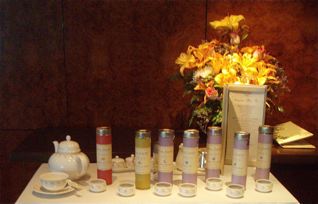 It’s easy to get caught up in the hustle and bustle of the holiday season and inadvertently forget about setting aside time to help keep yourself healthier during the holidays.
It’s easy to get caught up in the hustle and bustle of the holiday season and inadvertently forget about setting aside time to help keep yourself healthier during the holidays.
Sometimes you need to just stop, catch your breath, and maybe even sit down and treat yourself to a wonderfully aromatic warm cup of tea!
It’s important to keep up your antioxidant intake during the winter months and as we noted in Part 1 of 3 of this blog series, especially green and/or black tea made from the tea leaves of the Camellia senesis plant can be an excellent source of important flavonoids.
(Image of Christmas Tree + ornaments courtesy of dyet at rgbstock.com)
You might be wondering how to get the most “bang for your buck” out of the tea you steep, so let’s see if some researcher insights can shed some light on that.
Is It Better to Brew Tea “Loose” or in “Bags”?
The Tea Association of the USA estimated that as of the year 2010, over 65% of the tea brewed in the US was prepared using tea bags.
As a rule, researchers have found that the maturity of the tea leaves and their processing, along with tea quantity, variety (type & style), along with brewing technique all influence the resulting flavonoid content of the brewed tea.
The three main flavonols found in tea include: catechins (more in green vs. black tea); theaflavins (more in black vs. green tea); and thearubigins (more in black vs. green tea). BTW, decaffeination reduces catechins more so in black tea than in green tea.
When researchers compared the flavonoid content of brewed tea, they found a slightly higher flavonoid level when a given black tea was brewed in a “loose” form vs. in a “bag” form. They literally cut open tea bags to do their testing.
That doesn’t mean that you can’t obtain valuable antioxidants from brewing tea in a bag form, it is just that you might extract a little bit more antioxidant content (perhaps 10-30%) if you free the tea from the bag before you brew your tea.
How Long Should You Brew Black Tea?
Tea connoisseurs (including those who have become Tea Sommeliers and/or Certified Tea Specialists) may have different opinions on how to optimally extract the greatest flavor from tea leaves when brewing them.
We all want good flavor from any tea we steep at home or consume at a Christmas Tea or other tea event.
Health researchers, on the other hand, have tried to determine just how long to brew any tea to extract the greatest antioxidant content measured in terms of flavonoid levels.
~ 4 minutes appears to be the optimal time for brewing any loose, black tea leaves if the concern is for obtaining optimal antioxidant benefits from it. Note that this was only determined for black tea per se. As it happens, that also matches the time for steeping that the tea flavor experts suggest.
As noted above, if the same quantity and variety of tea are brewed in 6 & 2/3 oz (~200 ml) of water, researchers found they could extract a slightly higher level of flavonols from “loose” as opposed to “bag” black tea. Note that adding fat-free/skim milk or other milk/dairy products to brewed tea was found to reduce the total antioxidant capacity of brewed black tea.
Keep in mind that as a rule, dry green and black teas contain what researchers describe as similar amounts of all the various flavonols combined–in other words, similar TOTAL flavonoid content.
So although green tea is specifically much higher in catechins, while black tea is specifically higher in both theaflavins and thearubigins, both tea types are considered to offer potential health benefits. That means if you prefer one tea type over another, you can still count on obtaining some valuable antioxidant benefits from it.
BTW, the reason black tea is higher in the latter two flavonol categories is because the levels of them will increase as the tea leaves are fermented, while the levels of catechins will decrease during the fermentation of tea leaves.
Tea’s Caffeine Content
 As previously mentioned, the tea plant is called Camellia senesis and technically only elements from that plant are considered to be in the category of true tea by the tea purists.
As previously mentioned, the tea plant is called Camellia senesis and technically only elements from that plant are considered to be in the category of true tea by the tea purists.
Nonetheless, other herbs are frequently used alone or in various combinations, including with various types of tea plant components, and then sold and used as teas. You can check out a previous blog post we put up in February 2012 for additional details on that. As we mentioned in the Part 1 post of this blog series, non-tea leaf based “herbal preparations” are called tisanes. Many are very popular, particularly among folks who prefer to avoid excess caffeine consumption as many tisanes are caffeine-free.
For the purpose of discussing the caffeine content of tea, the following is based only on tea made purely from Camellia senesis plant parts.
Tea contains (among other components) caffeine, theanine, theobromine, and theophylline, all of which have been reported by researchers to potentially affect a person’s mental health and their mood.
Moderate to higher caffeine intake from any source has been reported by researchers to potentially improve adult concentration and mental alertness, give fat burning a boost, as well as improve adult mood, improve muscle contractions and reaction time as well as other elements that affect physical performance, improve short-term recall, and even improve work performance. Moderate to higher caffeine intake has also been associated with a reduced perception of adult fatigue.
Anecdotal reporting from individuals with a history of sinus headaches (confirmed by the National Headache Foundation) notes some have found relief from sinus headaches by consuming low to moderate levels of caffeine (comparable to those found in a single cup of tea). Caffeine dilates blood vessels, thus it can work alone or can assist in the effectiveness of sinus headache analgesics. Similar anecdotal reports from those with a history of asthma also note perceived improved lung function with easier breathing during moderate exercise if a level of caffeine comparable to that found in tea is consumed prior to engaging in activities such as hiking, etc. If you have any health issues, you should discuss potential caffeine concerns with your own personal health care provider(s).
Higher intakes of caffeine per day have been associated with concerns for a non-pregnant adult taking a longer time to fall asleep and perhaps experiencing a lower overall sleep quality, but researchers noted those observations were usually associated with either a single higher caffeine dose (~150 mg) or a total daily intake of greater than 400 mg. of caffeine.
Additionally, higher intakes of caffeine have also been associated with various GI tract symptoms including an upset stomach, as well as with central nervous system symptoms such as anxiety and/or headache. In terms of headaches, according to the National Headache Foundation, technically, only after two full weeks of faithfully consuming more than 200 mg of caffeine daily and then suddenly discontinuing it can a person be officially diagnosed as having a caffeine withdrawal headache. It is thought that the body might adapt to having the blood vessel dilation associated with such usual caffeine intake and that when that intake is abruptly cut off, sudden headache onset could result.
Researchers feel that home brewed tea may be less likely to disrupt an adult’s sleep patterns than intake of a similar volume of caffeinated coffee. This is because as a rule, researchers have found that cup-for-cup, brewed tea typically has lower caffeine levels than brewed coffee.
 Although figures given for caffeine content of teas will vary depending upon some of the same factors that can influence measuring antioxidant levels in teas, especially tea quantity, variety (type & style), along with brewing technique, researchers estimate that caffeine content in tea is generally about 1/3 to 1/2 that found in comparable amounts of brewed coffee (where caffeine content can also vary depending upon multiple parameters).
Although figures given for caffeine content of teas will vary depending upon some of the same factors that can influence measuring antioxidant levels in teas, especially tea quantity, variety (type & style), along with brewing technique, researchers estimate that caffeine content in tea is generally about 1/3 to 1/2 that found in comparable amounts of brewed coffee (where caffeine content can also vary depending upon multiple parameters).
Brewed “cups” of tea (6 & 2/3 oz or ~ 200 ml) typically contain between ~ 37.5 – ~ 75 mg of caffeine; compared to brewed similar size “cups” of coffee, which typically contain between ~75 – ~ 150 mg of caffeine.
It is also reported that the L-theanine in green tea is linked to feelings of relaxation and appears to neutralize some of caffeine’s potentially more negatively perceived effects (since tea’s caffeine content can be linked to improved muscle contractions).
Any non-pregnant adults used to consuming no or lower levels of caffeine will definitely be more affected if they suddenly start increasing their caffeine intake, however, it is felt that at or below a daily intake of 400 mg of caffeine, the majority of non-pregnant adults are unlikely to experience clinically significant sleep disturbances per se.
Please note that researchers have advised pregnant women to be more cautious with their total caffeine intake and not have it exceed 300 mg/day. Many women still choose to keep their caffeine intake as low as possible during their pregnancy.
According to the research, most adults who keep their green or black tea consumption at a moderate level of brewed “cups” and choose not to add any milk/dairy or sugar source may have the greatest potential to enjoy some of tea’s many possible health benefits. One way an adult might interpret that is to consume brewed tea containing closer to 37.5 mg caffeine/”cup” for a total of between 3 – 8 “cups” per day for a total caffeine intake from said brewed tea being ~ 112.5 – 300 mg.
Why not take the opportunity to learn more about the many varieties of tea? Whether sold loose or in bags, lots of brewable tea options are available right now. Some of those products will actually only be featured in a wider range of stores or tea shops/tea rooms or restaurants, etc., specifically for the holiday season.
Moderate consumption of tea holds promise for a host of potential health benefits for many individuals and not all are associated with any flavonoid or caffeine content the tea might have.
Time to get out a real tea pot with a built-in strainer or else a large tea ball for brewing some flavorful tea this Fall & coming Winter!
Enjoy the holidays and hopefully enjoy a cup of tea as well!
Do you have a favorite type of black or green tea and a favorite purveyor you use? Feel free to share your suggestions with family, friends, and if you wish, here as well.
In Part 3 of 3 of this blog series we’ll mention about some other potential health benefits & concerns surrounding tea consumption. We’ll focus on staying hydrated and the role tea might play in that, a role tea might have in better oral and bone health, is tea possibly linked to graceful aging, and if tea might have a role in weight management.
Remember that this site only offers infotainment and you are always urged to contact your own health care provider to discuss options when it comes to your unique personal health status and how your personal dietary choices may impact your health.
*In developing this 3 part blog series, we would like to particularly acknowledge access to information available through the Tea Association of the USA, including their 2010 Tea Fact Sheet as well as TEA AND HEALTH (An Overview of Research on the Potential Health Benefits of Tea) developed by Maggie Moon, MS, RD of Pollock Communications for that tea association; and through Tea Time: The Health Benefits of Tea (Online Learning Module SKU 6500) of Food & Nutrition Magazine, the Academy of Nutrition and Dietetics, developed by Victoria Shanta Retelny, RD, LDN and Neva Cochran MS, RD, LD as an adjunct Continuing Professional Education (CPE) module to the Summer 2012 (Volume 1, Issue 2) of Food & Nutrition Magazine Tea Time feature story authored by Joanna Pruess and Neva Cochran MS, RD, LD; as well as the National Headache Foundation Clinical Update: Caffeine and Headache module.

